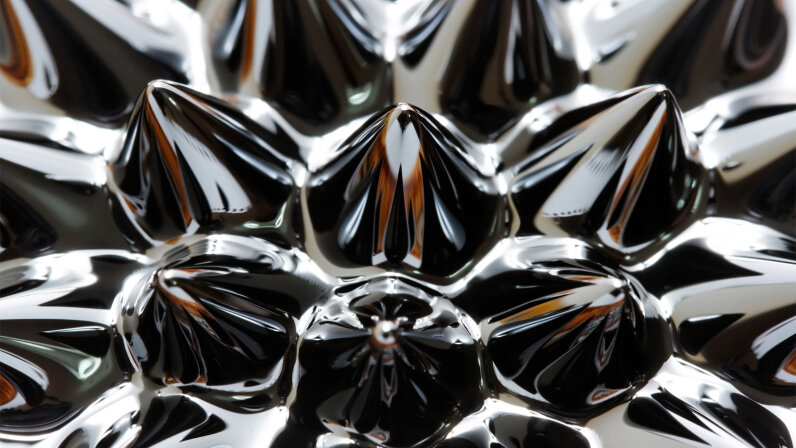 |
| Ultra close-up of a ferrofluid, or magnetic colloidal liquid, which becomes strongly magnetized in the presence of a magnetic field and can be used in ways that solid magnets cannot. |
Liquid Magnets
New Liquid Magnets Go Places Solid Magnets Can't
BY PATRICK J. KIGER
Back in the
second century B.C.E., the Chinese developed a spoon-shaped compass made of lodestone,
or magnetite ore, which was capable of helping them figure out the directional
position of north.
Since then,
inventors have found all sorts of other ways to use magnets, ranging from
magnetic audio and videotapes, to computer hard drives and MRI
machines for scanning the insides of the human body, to those
magnets that you use for sticking your kids' drawings to the refrigerator door.
Up to this
point, magnets have been made of solid
materials.
But now, in an
article published July 19, 2019, in the journal Science, researchers at the U.S. Department of
Energy's Lawrence
Berkeley National Laboratory reveal that they've figured out a
way to make a 3D-printed magnetic device out of liquid.
Liquid magnets
could be fantastically useful for creating tools that range from artificial
cells that deliver cancer-killing medication, to flexible liquid robots that
can change their shape and adapt to their surroundings. (Maybe T-1000 from
"Terminator 2: Judgment Day" isn't so far-fetched after all.)
"We've
made a new material that is both liquid and magnetic. No one has ever observed
this before," said Tom Russell, a visiting faculty scientist at
Berkeley Lab and professor of polymer science and engineering at the University
of Massachusetts, Amherst, said in a press release.
"This
opens the door to a new area of science in magnetic soft matter."
Russell and Xubo
Liu, the study's lead author, got the inspiration to try to form liquid
structures from ferrofluids — solutions of iron-oxide
particles that become magnetic in the presence of another magnet.
They used a
3-D printer to make tiny droplets, just 1 millimeter across, from a ferrofluid
solution containing iron-oxide nanoparticles that crowded at the droplet's
surface.
The research
team then put the droplets in a solution near a magnetic coil.
When they
removed the coil, the droplets gravitated toward each other and became
permanently magnetic.
NOW THAT'S INTERESTING
Back in 2013,
scientists constructed a tiny
magnet made of just five iron atoms.
Patrick
J. Kiger
has written for HowStuffWorks since 2008 covering a wide array of topics, from
history and politics to pop culture and technology. He worked as a newspaper
reporter for the Pittsburgh Press, and the Orange County Register in
California, where he covered one of the biggest serial murder cases in U.S.
history, and also as a staff writer at Baltimore Magazine. As a freelancer,
Patrick has written for print publications such as GQ, Mother Jones and the Los
Angeles Times, and on the web for National Geographic Channel, Discovery News,
Science Channel and Fast Company, among others. In recent years, he's become
increasingly interested in how technological advances are altering urban life
and the design of cities, and has written extensively on that subject for Urban
Land magazine. In his spare time, Patrick is a longtime martial arts student
and a fan of crime fiction, punk rock and classic Hollywood films.


No comments:
Post a Comment